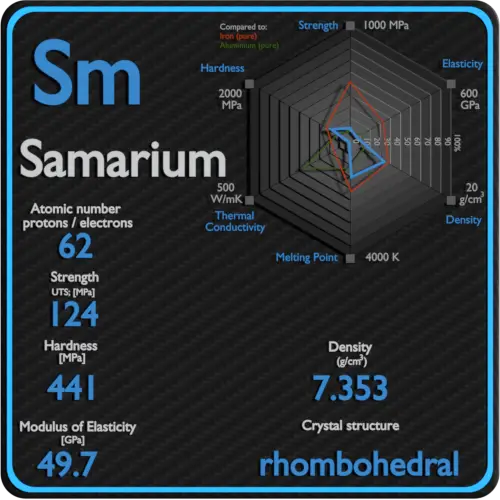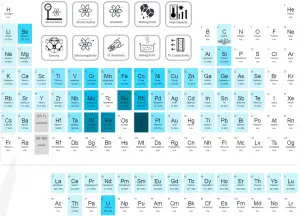About Samarium
Samarium is a typical member of the lanthanide series, it is a moderately hard silvery metal that readily oxidizes in air. The name samarium is after the mineral samarskite from which it was isolated. Although classified as a rare earth element, samarium is the 40th most abundant element in the Earth’s crust and is more common than such metals as tin. In nuclear industry, especially natural and artificial samarium 149 has an important impact on the operation of a nuclear reactor. Samarium 149 has a very large neutron capture cross-section (about 42,000 barns). Since natural samarium contains about 14% of 149Sm, it can be used as an absorbing material in control rods.
Summary
| Element | Samarium |
| Atomic number | 62 |
| Element category | Rare Earth Metal |
| Phase at STP | Solid |
| Density | 7.353 g/cm3 |
| Ultimate Tensile Strength | 124 MPa |
| Yield Strength | 110 MPa |
| Young’s Modulus of Elasticity | 49.7 GPa |
| Mohs Scale | N/A |
| Brinell Hardness | 441 MPa |
| Vickers Hardness | 412 MPa |
| Melting Point | 1074 °C |
| Boiling Point | 1900 °C |
| Thermal Conductivity | 13 W/mK |
| Thermal Expansion Coefficient | 12.7 µm/mK |
| Specific Heat | 0.2 J/g K |
| Heat of Fusion | 8.63 kJ/mol |
| Heat of Vaporization | 192 kJ/mol |
| Electrical resistivity [nanoOhm meter] | 940 |
| Magnetic Susceptibility | +1860e-6 cm^3/mol |
Applications of Samarium
Samarium is mainly used in preparing samarium-cobalt alloy magnets for electric guitars, small motors and headphones. Samarium-cobalt magnets are much more powerful than iron magnets. They remain magnetic at high temperatures and so are used in microwave applications. They enabled the miniaturisation of electronic devices. However, neodymium magnets are now more commonly used instead. Its oxide is used for manufacturing special infrared adsorbing glass for carbon arc-lamp electrodes. It is useful in doping calcium fluoride crystals employed in optical lasers.
Production and Price of Samarium
Raw materials prices change daily. They are primarily driven by supply, demand and energy prices. In 2019, prices of pure Samarium were at around 1300 $/kg.
Samarium occurs with concentration up to 2.8% in several minerals including cerite, gadolinite, samarskite, monazite and bastnäsite, the last two being the most common commercial sources of the element. These minerals are mostly found in China, the United States, Brazil, India, Sri Lanka and Australia; China is by far the world leader in samarium mining and production.
Source: www.luciteria.com
Mechanical Properties of Samarium
Strength of Samarium
In mechanics of materials, the strength of a material is its ability to withstand an applied load without failure or plastic deformation. Strength of materials basically considers the relationship between the external loads applied to a material and the resulting deformation or change in material dimensions. In designing structures and machines, it is important to consider these factors, in order that the material selected will have adequate strength to resist applied loads or forces and retain its original shape. Strength of a material is its ability to withstand this applied load without failure or plastic deformation.
For tensile stress, the capacity of a material or structure to withstand loads tending to elongate is known as ultimate tensile strength (UTS). Yield strength or yield stress is the material property defined as the stress at which a material begins to deform plastically whereas yield point is the point where nonlinear (elastic + plastic) deformation begins.
See also: Strength of Materials
Ultimate Tensile Strength of Samarium
Ultimate tensile strength of Samarium is 124 MPa.
Yield Strength of Samarium
Yield strength of Samarium is 110 MPa.
Modulus of Elasticity of Samarium
The Young’s modulus of elasticity of Samarium is 110 MPa.
Hardness of Samarium
In materials science, hardness is the ability to withstand surface indentation (localized plastic deformation) and scratching. Brinell hardness test is one of indentation hardness tests, that has been developed for hardness testing. In Brinell tests, a hard, spherical indenter is forced under a specific load into the surface of the metal to be tested.
Brinell hardness of Samarium is approximately 441 MPa.
The Vickers hardness test method was developed by Robert L. Smith and George E. Sandland at Vickers Ltd as an alternative to the Brinell method to measure the hardness of materials. The Vickers hardness test method can be also used as a microhardness test method, which is mostly used for small parts, thin sections, or case depth work.
Vickers hardness of Samarium is approximately 412 MPa.
Scratch hardness is the measure of how resistant a sample is to permanent plastic deformation due to friction from a sharp object. The most common scale for this qualitative test is Mohs scale, which is used in mineralogy. The Mohs scale of mineral hardness is based on the ability of one natural sample of mineral to scratch another mineral visibly.
Samarium is has a hardness of approximately N/A.
See also: Hardness of Materials
Samarium – Crystal Structure
A possible crystal structure of Samarium is rhombohedral structure.
In metals, and in many other solids, the atoms are arranged in regular arrays called crystals. A crystal lattice is a repeating pattern of mathematical points that extends throughout space. The forces of chemical bonding causes this repetition. It is this repeated pattern which control properties like strength, ductility, density, conductivity (property of conducting or transmitting heat, electricity, etc.), and shape. There are 14 general types of such patterns known as Bravais lattices.
See also: Crystal Structure of Materials
Crystal Structure of Samarium

Thermal Properties of Samarium
Samarium – Melting Point and Boiling Point
Melting point of Samarium is 1074°C.
Boiling point of Samarium is 1900°C.
Note that, these points are associated with the standard atmospheric pressure.
Samarium – Thermal Conductivity
Thermal conductivity of Samarium is 13 W/(m·K).
The heat transfer characteristics of a solid material are measured by a property called the thermal conductivity, k (or λ), measured in W/m.K. It is a measure of a substance’s ability to transfer heat through a material by conduction. Note that Fourier’s law applies for all matter, regardless of its state (solid, liquid, or gas), therefore, it is also defined for liquids and gases.
Coefficient of Thermal Expansion of Samarium
Linear thermal expansion coefficient of Samarium is 12.7 µm/(m·K)
Thermal expansion is generally the tendency of matter to change its dimensions in response to a change in temperature. It is usually expressed as a fractional change in length or volume per unit temperature change.
Samarium – Specific Heat, Latent Heat of Fusion, Latent Heat of Vaporization
Specific heat of Samarium is 0.2 J/g K.
Heat capacity is an extensive property of matter, meaning it is proportional to the size of the system. Heat capacity C has the unit of energy per degree or energy per kelvin. When expressing the same phenomenon as an intensive property, the heat capacity is divided by the amount of substance, mass, or volume, thus the quantity is independent of the size or extent of the sample.
Latent Heat of Fusion of Samarium is 8.63 kJ/mol.
Latent Heat of Vaporization of Samarium is 192 kJ/mol.
Latent heat is the amount of heat added to or removed from a substance to produce a change in phase. This energy breaks down the intermolecular attractive forces, and also must provide the energy necessary to expand the gas (the pΔV work). When latent heat is added, no temperature change occurs. The enthalpy of vaporization is a function of the pressure at which that transformation takes place.
Samarium – Electrical Resistivity – Magnetic Susceptibility
Electrical property refers to the response of a material to an applied electric field. One of the principal characteristics of materials is their ability (or lack of ability) to conduct electrical current. Indeed, materials are classified by this property, that is, they are divided into conductors, semiconductors, and nonconductors.
See also: Electrical Properties
Magnetic property refers to the response of a material to an applied magnetic field. The macroscopic magnetic properties of a material are a consequence of interactions between an external magnetic field and the magnetic dipole moments of the constituent atoms. Different materials react to the application of magnetic field differently.
See also: Magnetic Properties
Electrical Resistivity of Samarium
Electrical resistivity of Samarium is 940 nΩ⋅m.
Electrical conductivity and its converse, electrical resistivity, is a fundamental property of a material that quantifies how Samarium conducts the flow of electric current. Electrical conductivity or specific conductance is the reciprocal of electrical resistivity.
Magnetic Susceptibility of Samarium
Magnetic susceptibility of Samarium is +1860e-6 cm^3/mol.
In electromagnetism, magnetic susceptibility is the measure of the magnetization of a substance. Magnetic susceptibility is a dimensionless proportionality factor that indicates the degree of magnetization of Samarium in response to an applied magnetic field.


























